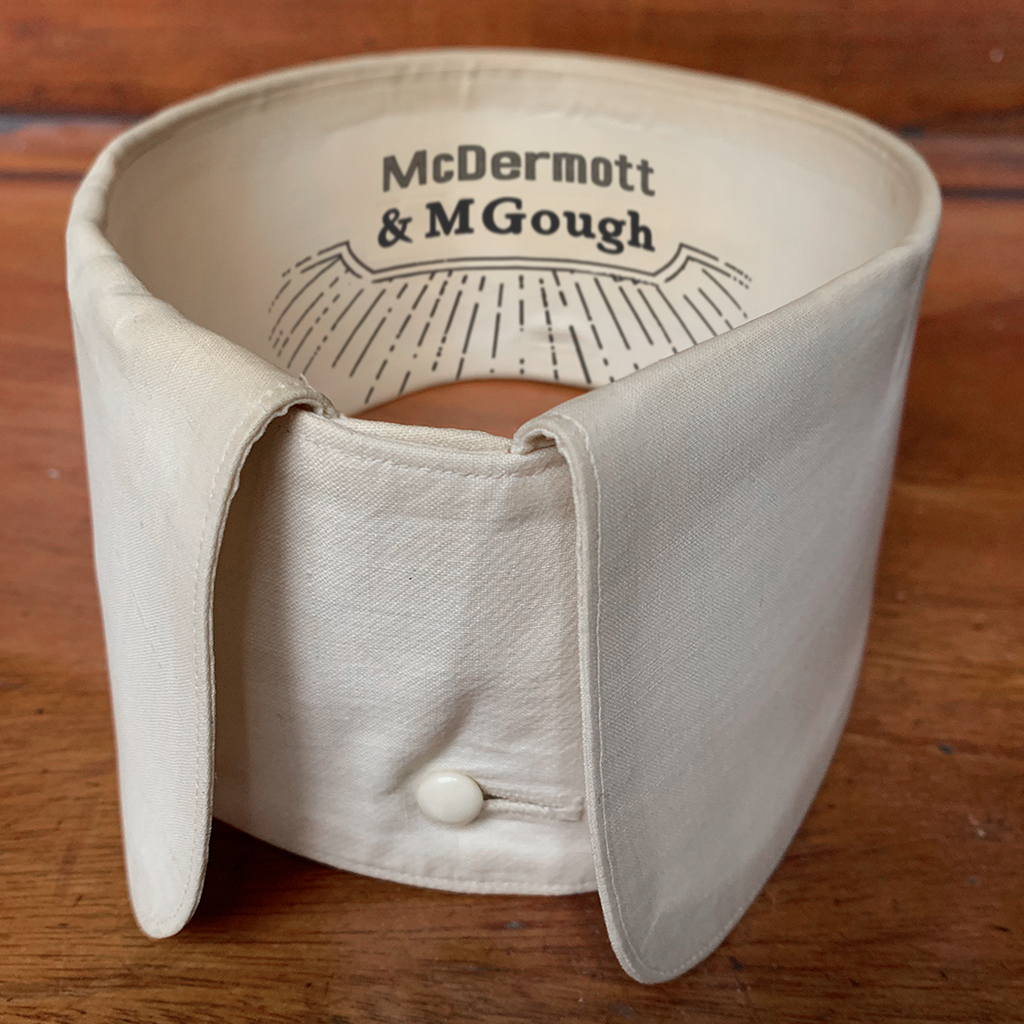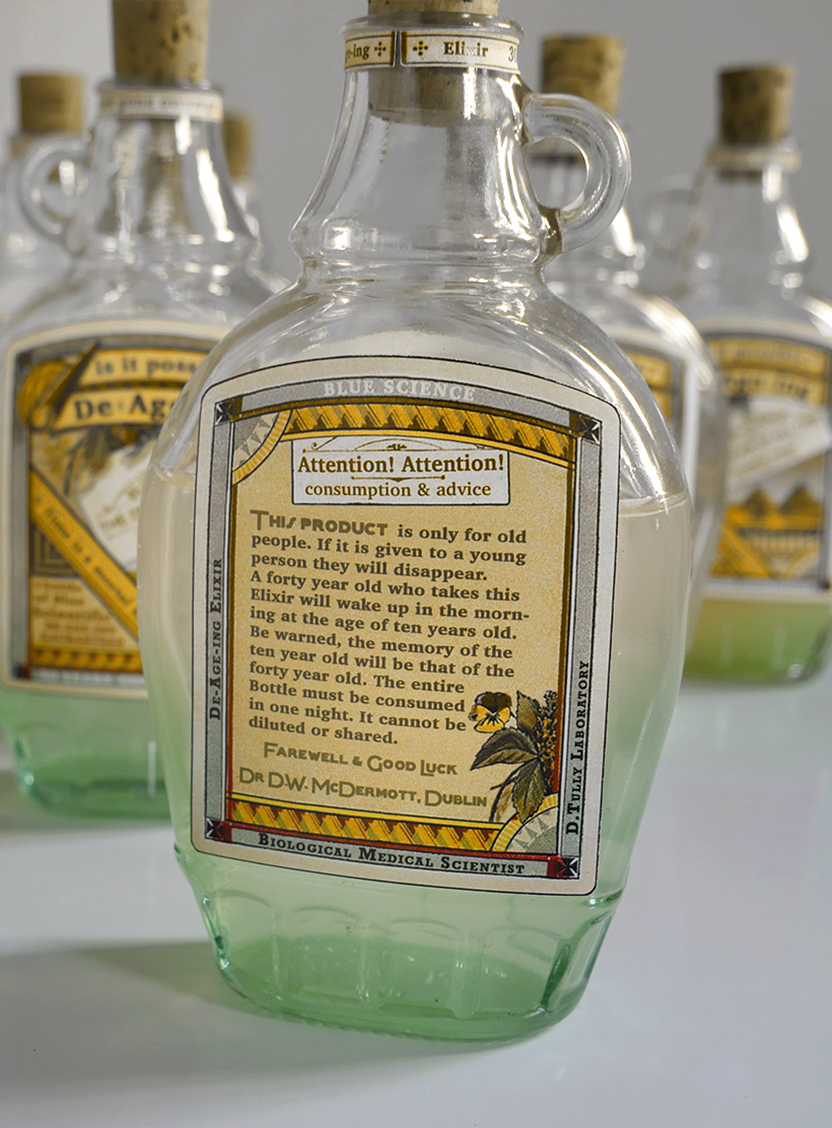McDermott & McGough
Background
McDermott & McGough are collaborative time-based artists who live work between Dublin and New York. Their practice consists of painting, film, sculpture and photographic works. Inspired by the Victorian era, they dress and live lives as members of this era. Limiting themselves technologically and wearing top hats and other Victorian garb day-to-day. They employ historical techniques to make their work. Which includes cyanotypes, platinum plates, and other 19th century photographic methods. They emerged from the East Village art scene in the 80s. Along with such contemporaries as Keith Haring, Jean-Michel Basquiat, Peter Halley, and Jeff Koons. Very much in part thanks to the support of artist and friend Julian Schnabel.
Detachable Collars
The detachable collar has a fascinating history that dates back to the early 19th century. The story begins with Hannah Montague, a woman from Troy, New York, who in 1827, invented the detachable collar to simplify the task of keeping her husband's shirts clean. Montague's innovative idea was to cut off the collar from the shirt, wash it separately. Then reattach it using buttons or studs. This allowed for the collar to be cleaned independently of the shirt, saving time and labor.The idea quickly gained popularity. A local businessman, Reverend Ebenezer Brown, commercialized the concept by paying local women to sew detachable collars. The detachable collar soon became a staple of men's fashion, particularly among the upper class. As it was seen as a symbol of social affluence and cleanliness. The collars were typically made of starched linen. Which was stiffened to hold its shape and give it a crisp, formal appearance.
Cabinet Collection, Rare 19th Century Collars
Fabrication
Bellmount House is pleased to re-release "The High Lounge Detachable Collar". McDermott & McGoughs first detachable collar created in the late 80s. These collars are made of starched linen, locally produced in Dublin. And includes their original Art-Deco styled label. Screen-printed on the inside (see image).
The construction of "The High Lounge Detachable Collar" involves a meticulous process to ensure a sturdy and durable product. The cotton fabric is carefully cut and sewn to create a stiff, yet pliable, collar that can be easily attached and detached from a shirt. The neckline measures 39 cm, the collar shoulder-width is 33 cm, the front length is 13 cm, and the back length is 9.5 cm, providing a comfortable fit for most individuals.
The High Lounge Collar is worn for informal after dinner evening engagements.
High Lounge Detachable Collar, No.1
Sock Stretchers
The use of sock stretchers became widespread in the 19th century, particularly in North America, where they were used to prevent the shrinking of socks after washing. Sock stretchers were typically made of wood, with carved legs that resembled human legs. They were used to hold socks in place while they dried, allowing them to maintain their shape and size. In the early 20th century, the use of sock stretchers began to decline with the introduction of new materials like nylon, which were less prone to shrinking.
The 1905 Sock Stretcher
Fabrication
"The 1905 Sock Stretcher" by McDermott & McGough denotes the last year sock stretchers were generally mass produced. However, in collaboration with Bellmount House we felt it's a somewhat easy and interesting "Art Object" to bring back to life. Also, it celebrates the artistic essence of McDermott & McGough. By reintroducing this humble forgotten household object. Something people are (currently) vaguely familiar with. Our Sock Stretchers are crafted from recycled wood. Laminated with transferable illustrations and sealed with natural Beeswax. Measuring approximately 200mm x 400mm. See below, Series No. 1.
Sock Stretcher, recycled wood 2023
Elixir
During the late 19th and early 20th centuries, the market for patent medicines, also known as elixirs, tonics, and snake oil, was at its peak. These medicinal concoctions often claimed to cure a wide range of ailments, earning them the nickname "cure-alls." The term "patent medicine" is misleading, as it did not refer to the mixture itself being patented, but rather the design of the labels and bottles. The ingredients were not required to be listed on the label, and many contained substances like alcohol, cocaine, and heroin. The rise of patent medicines can be attributed to several factors, including a lack of understanding of the causes and cures of illnesses, the trust in herbal remedies passed down through generations, and the convenience and affordability of these medicines compared to consulting a physician. Additionally, the end of the Civil War led to an increase in demand for pain medicines, which patent medicines claimed to provide. These medicines were marketed as cures for a wide range of ailments, from whooping cough and tuberculosis to rheumatism and dyspepsia. However, they often contained ingredients like opium derivatives, cocaine, and alcohol, which were the actual active ingredients providing relief, rather than the touted herbal remedies.The marketing of these medicines was often sensational and misleading, with advertisements claiming they could cure everything from baldness to cancer. Snake oil salesmen, who traveled the country selling these elixirs, were known for their entertainment value as much as their sales pitches. However, the use of opium and morphine in these medicines led to widespread addiction, particularly among Civil War veterans who had been prescribed these drugs for pain management. Eventually, the government cracked down on the false claims made by patent medicine manufacturers, passing the Food and Drugs Act of 1906, which required the listing of dangerous ingredients on labels and prohibited false or misleading advertising. This led to the decline of the patent medicine industry, as many companies were forced to change their labels or go out of business.
Fabrication
Embellishing upon "patent medicines" of 19th Century, McDermott & McGough with Bellmount House bring you a mysterious de-age-ing remedy called "Blue Science". Corked in appropriated glass vintage syrup bottles. Please read the label carefully. "This product is only for old people. If it is given to a young person they will disappear. A forty year old who takes this Elixir will wake up in the morning at the age of ten years old. Be warned, the memory of the ten year old will be that of the forty year old. The entire Bottle must be consumed in one night. It cannot be diluted or shared. Farewell & Good Luck. Dr DW. McDermott, Dublin"






